The Facts Every Parent Should Know About Noise-Induced Damage

We, as parents, do all to shield our kids right from feeding them well to making sure they’re safe while playing. Yet, we often ignore one hidden threat: noise. Our kids face a barrage of loud noises, from noisy toys to non-stop video time with headphones, conditions in modern life that could hurt their tender ears.
The number of kids getting Noise-induced hearing loss (NIHL) is going up. This isn’t a short-term problem. Once it’s there, you can’t fix hearing all the way, and this could mess with how a kid talks, learns, and connects with everything around them. However here’s a bit of hopeful chatter: by knowing what’s up and taking some easy steps, you can protect your young one’s hearing helping them enjoy a future full of clear sounds.
In our post today, we’re diving into all the key stuff moms and dads got to get about kids getting hearing loss from too much noise. We’ll show a what’s considered way too noisy and clue you in on the first signs that trouble’s brewing. This rundown’s going to give you the tools you need to step in and safeguard your kiddo’s super important hearing. Time to jump in!
1. The Hidden Risks of Noise: Are Your Child’s Daily Activities Hurting Their Hearing?
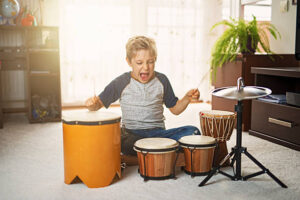
Kids have a bunch of noise around them all the time, and it looks like no biggie. But those regular noises might be sneakier hazards than you think. Talking’ about toys, video games loud classrooms, and packed places – all this racket could be messing with your kid’s ears.
a. Everyday Noise Culprits
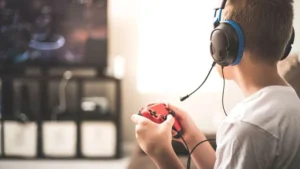
- Toys: You know, some toys, like the ones that blast out police sirens or tunes, can crank out sounds over 90 decibels (dB). To give you an idea, that’s booming louder than a street clogged with cars, and if kids listen to that racket too long, it could trash their hearing.
- Gaming Devices and Headphones: So when kids have their headphones glued on or they’re diving into their gaming headsets, they sometimes crank it high. We’re talking 100 dB or higher! That’s no joke and can mess up their hearing if they keep at it for a bunch of time.
- School Environments: Ever think about how loud schools can get? Places like the packed lunchroom, the gym, or even where they have band practice can hit noise levels that push our kids’ ears to the limit. “Malls, theme parks, and family events can be noisy. This noise makes it tough for kids’ ears to get better after they’ve been around loud sounds.
b .Effects of Being Around Noise a Lot Over Time

You won’t lose your hearing right away if you’re always around sounds that are sort of loud or loud. That’s why lots of folks don’t pay attention to it much. But if you keep it up, after a while, it might lead to stuff like:
- Noise-Induced Hearing Loss (NIHL): The teeny tiny hairs in your inner ear can get wrecked, and bam, your hearing’s gone for good.
- Brain Hurdles: If you’re hustling to hear, it’s tougher for kids to stay sharp and get the info so learning stuff gets all bumpy.
- Trouble with Friends: Kids who can’t hear well might not chat as much, and that can leave them feeling lonely or not too great about themselves.
c. Making Less Noise in Your Everyday
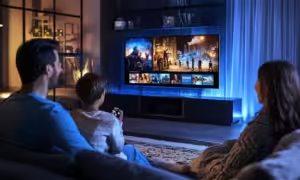
- Limit Headphone Use: Encourage kids to take breaks from headphones and follow the 60/60 rule (more on this later).
- Choose Quieter Toys: Opt for toys with safe noise levels or those that don’t make noise at all.
- Use Ear Protection: In noisy environments like concerts or amusement parks, provide earplugs or noise-canceling headphones for your child.
- Set Volume Limits: Many devices allow you to set a maximum volume limit to prevent excessive noise exposure.
2.Noise-Hurt Ears: Why Little Ones Get It Worse Than Grown-ups
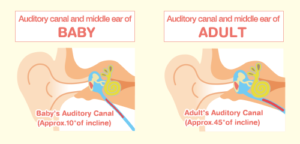
Little guys have a higher risk of their ears getting hurt by loud noises than grown-ups do. If you get why, it’s like that, you can be ahead of the game in keeping their eardrums safe.
a. How a Kid’s Ear is Built
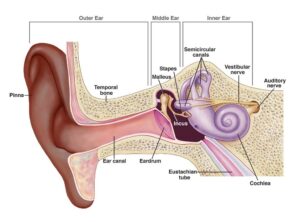
Kids have ears that are changing and growing, and they pick up sounds more ‘because their ear holes are tinier than grown-ups’. So, what this means is that what’s just regular loud for us can seem super loud to them, and that’s not too good for their ears.
b. The Trouble with Loud Noises Early On
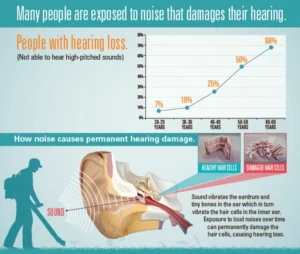
When little ones hear too much noise too soon, it can mess with them for a long time:
- Irreversible Hearing Damage: Damaged hair cells in the inner ear don’t heal.
- Learning Setbacks: Hearing difficulties may delay how fast children pick up languages complicating their ability to chat with others.
- Emotional Repercussions: Hardships in hearing might bring on annoyance, loneliness, or feeling out of place among buddies.
c. Spreading the Word to Moms Dads, and Teachers

- Instructing Caregivers: Pass along the know-how for keeping ears safe and cutting back on noise.
- Supporting Teachers: Instructors can lend a hand by softening the volume in classrooms and keeping tabs on the racket during group projects.
- Setting Examples: Kids tend to imitate when their folks take hearing protection.
3.Ear-Safety Tips Parents Must Teach Their Youngsters
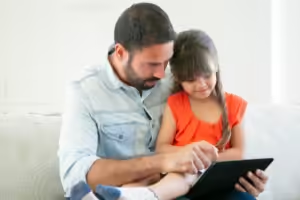
Teaching your kids to listen can shield their ears for their whole lives. Here’s your guide to help.
a. Kids and the 60/60 Method
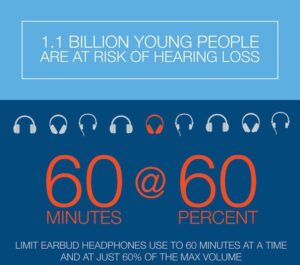
The 60/60 method is super easy and makes sure kids use headphones without risk:
- Loudness: Don’t turn the volume higher than 60% of its total power.
- Time: listen for 60 minutes then take a break. Push your children to stick to this method when they’re plugged into headphones playing video games, or glued to clips.
b. Bringing the Fun to Hearing Protection

Noise-blocking ear wear for youngsters is a smart purchase. It drowns out the din so they won’t have to jack up their tunes. Scour for kid-tailored choices that cap how loud they can go.
c. Bringing the Fun to Hearing Protection
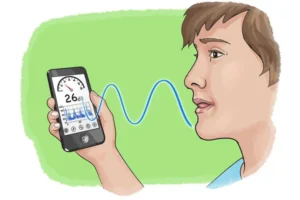
- Decibel Detecting Competitions: Let the little ones scope out noise levels with apps or gizmos and figure out what’s cool for the ears.
- Engaging Info Sessions: Hook them on ear care with lively vids or tales.
- Treat-based Incentives: Sweeten the deal for sound listening moves; toss them a treat for sticking to the 60/60 rule or suiting up with ear gear.
4. Noisy Playthings, Huge Hassles: The Jarring Scoop on Kiddos’ Top Toys
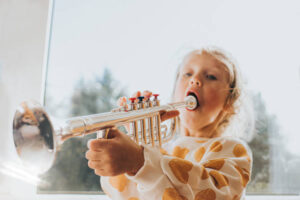
Loads of toys for kids out there can be quite the noisemakers, blasting sounds that go way past what’s good for those tiny ears. Parents, you’ll want to pay attention here.
a. When Does Loud Become Too Much?

Okay so the magic number here is 85 dB – that’s the safe zone for kiddos. But get this, those toys that come with screaming sirens, pumping’ music, or cool sound effects? They can crank it up to a whopping 120 dB! Just a little time around that racket, and we’re talking real ear trouble.
b. Picking Toys That Are Sweet to the Ears
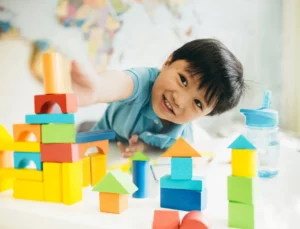
- Check the Tags: Often, you’ll find the max sound level detailed on the toy’s box.
- Give it a Go Before You Get It: You should try out the toy to check how loud it is. If it blasts your ears, it’s not going to be good for the kiddo.
- Tone Down Noisy Toys: Slap some tape over the speaker to muffle it or just don’t let them play with it close up.
c. Pushing Companies to Think Safety First
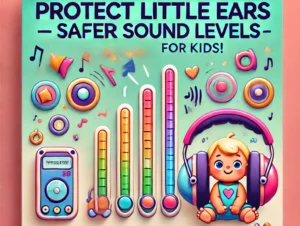
Here’s how you can push for tougher sound rules with toys:
- Back up brands that care about keeping noise levels down.
- Talk about it in your reviews and on social media to get the word out.
- Jump into campaigns that are fighting for top-notch noise control standards.
5. Shielding Little Ears: Easy Steps to Lessen Hearing Damage from Noise at Home and in School

Making places less noisy is key to protecting your kid’s hearing:
a. Home Sound Hazards

- Home Gadgets: Stuff like mixers, hair dryers, and hoovers can get noisy. Try not to use these too much when the young ones are around.
- Sound Levels: Don’t blast the volume on TVs and stereo systems.
- Silence Breaks: Have times of no noise to give your kid’s hearing a chance to chill from all the loud sounds.
b. Reducing Down Noise at School
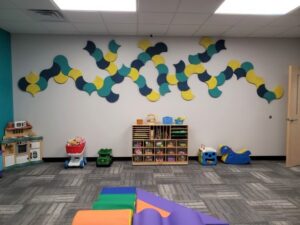
- Encourage schools to install soundproofing materials to reduce noise levels in classrooms.
- Management of Volume: Teachers should oversee the volume when students are playing or working in groups.
- Quiet Zones: Provide designated areas where kids can go to escape from all the noise.
c. Making Life Less Noisy

- Noise-Dampening Materials: Put down things like carpets, drapes, or panels made of foam to soak up noise in loud places.
- Outdoor Breaks: Go outside to let your child hear the peaceful sounds of nature.
- Mindful Practices: Support stuff like reading or sketching in a hushed spot to help manage the sound they hear every day.
Conclusion
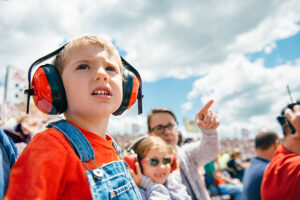
Preventing noise-induced hearing loss is doable, but you got to know what’s up and take steps. Get the lowdown on the dangers, show kids the right way to listen, and try to keep the noise down around them. This way, you’ll safeguard their ears and they’ll thank you later for a lifetime of sick sounds. Kick things off on a low-key, stick with it, and bump up that ear care game at your place and with your neighbours.
